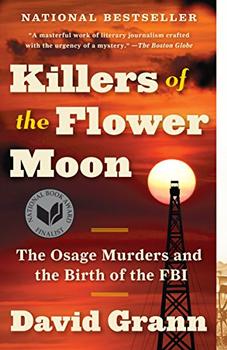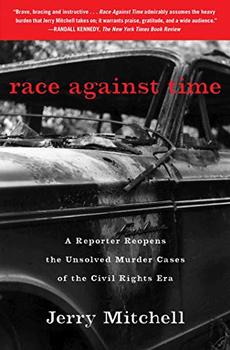Summary | Excerpt | Reviews | Beyond the book | Read-Alikes | Genres & Themes | Author Bio

The Osage Murders and the Birth of the FBI
by David GrannVoted 2017 Best Nonfiction by BookBrowse's Subscribers
The long, sorrowful list of injustices done to Native Americans by the U.S. Federal Government is well known by now. The wholesale relocation of tribes from their ancestral lands – and the subsequent violence and bloodshed that marked these tribes' trail of tears – is almost too large to get one's mind around. Maybe that's why smaller, localized campaigns of terror and intimidation against various Indian tribes are not so well known.
Most Americans have trouble processing the comprehensive horror of the centuries-long subjugation of the American Indian, a legacy of genocidal policies and human rights curtailment that still stains the psychic landscape today (and makes possible, for example, the thoughtless and offensive use of "Redskin" in the name of sports teams, an unequivocal legacy of disrespect and disdain for Native Americans, no matter how it is spun). Compared to the near-annihilation of many of the Plains Indian tribes, what's a few suspicious deaths anyway? In Oklahoma in the 1920s, the answer was a dismissive shrug: "White people in Oklahoma thought no more of killing an Indian than they did in 1724," said one hired gunman quoted by David Grann in his chilling and well-researched Killers of the Flower Moon: The Osage Murders and the Birth of the FBI.
Grann's book-length investigation of a series of suspicious murders among the Osage Indian Nation in Oklahoma in the 1920s tells a story that is so enraging and consequential that many readers will feel ashamed and alarmed that they've never known anything about this dark chapter of American history. The story Grann reports isn't new, exactly – his book recounts the investigations, trials, and legacy of these Osage murders, and the nationwide publicity they generated briefly in the 1920s. Grann not only provides a comprehensive overview of the crimes but also seeks to answer the question: In the almost one hundred years since the suspicious shootings, poisonings, bombings, and disappearance of dozens of Osage tribe members, have we learned anything new about who might be responsible beyond those few who were tried and convicted?
The early chapters of the book constitute a primer on the history and culture of the Osage nation. In one of the most ironic twists in the history of Native Americans, when the Osage Indians were corralled after the U.S. Civil War from their native settlements across the Ohio and Missouri river valleys and forced into "Indian Territory" in northern Oklahoma, they were relocated on "rocky, presumably worthless" land that, in a few years, would prove to be some of the richest oil land in North America. Once oil was discovered there, the Osage flourished, owning the mineral rights of the property as part of the relocation treaty they were forced to sign.
How much wealth did these oil lands generate for the Osage? "After oil was discovered beneath their land, the Osage rode in chauffeured automobiles, built mansions, and sent their children to study in Europe." They enjoyed a lifestyle that, per capita, exceeded in terms of personal wealth any other similarly sized region in the United States. But the consequences of such affluence led to untold attempts to swindle or steal the land rights from the Osage, who often spoke little or no English and further, were frequently placed under the "guardianship" of white men appointed by the local government to ensure "proper" oversight of their wealth (the theory being that simple-minded Osages were incapable of discharging their own financial affairs). In other words, they were being robbed blind. Sometimes the thefts were given moral cover by local governments, corrupt judges, sheriffs, and barristers. Sometimes it was just outright theft:
The passage of Prohibition had only compounded the territory's feeling of lawlessness by encouraging organized crime and creating, in the words of one historian, "the greatest criminal bonanza in American history." And few places in the country were as chaotic as Osage County, where the unwritten codes of the West, the traditions that bound communities, had unraveled.
Those Osage rights holders who refused to be tricked or intimidated into signing over their mineral rights were sometimes simply murdered, their rights reverting to a "guardian" (who, in most instances, had paid off the local authorities to be appointed to that role). Sometimes those murders were blatant: a shot between the eyes, or a house being blown to bits by dynamite. Sometimes, they were subtle: poisoned whisky, or injections from a "doctor" who was in the pay of a criminal syndicate. And sometimes, the Osage just disappeared. Dozens of Osage Indians were dispatched in this manner, their property rights by-passing their heirs and instead going directly to their "guardians." Grann suggests the actual number of Osage Indians who might have been killed for their land rights could number in the hundreds.
The murder of that many native Americans – even in Oklahoma at the time – could not be ignored, and after years of unsuccessful local and state investigations (almost all of which were doomed to fail because they were beset by corruption and bribery, and because "most officials seemed to have little concern for what they deemed a 'dead Injun'"), the federal government finally stepped in. The agency that would soon be known as the Federal Bureau of Investigation launched its first, widespread homicide investigation in Osage territory under the supervision of a young, ambitious federal investigator named J. Edgar Hoover.
Grann's recreation of the investigation is gripping. He recounts the details of the trial from published accounts at the time, and his years of archival research and interviews and the declassification of various documents once off limits allow him to provide a kind of annotation of the trial that lends both real-time excitement and the perspective of hindsight. Grann's shock at discovering that the murder plots against the Osage might have gone far beyond those outlined in the trial – and his zeal for discovering the parties responsible for the dozens of unprosecuted murders – makes Killers of the Flower Moon more entertaining than a book about such a dire subject should be. He seems driven to amend the historical record, to prosecute, even from the distance of several generations of history, those responsible for the deaths of these now-forgotten victims. Grann's powerful narrative resurrects a bitterly important chapter in American history, suggesting that the trail of tears doesn't have to lead to a dead end. It can circle back through justice, arriving, if not at reconciliation, then at least perhaps some closure.
![]() This review was originally published in The BookBrowse Review in April 2017, and has been updated for the
April 2018 edition.
Click here to go to this issue.
This review was originally published in The BookBrowse Review in April 2017, and has been updated for the
April 2018 edition.
Click here to go to this issue.

If you liked Killers of the Flower Moon, try these:

by Sierra Crane Murdoch
Published 2021
The gripping true story of a murder on an Indian reservation, and the unforgettable Arikara woman who becomes obsessed with solving it - an urgent work of literary journalism.

by Jerry Mitchell
Published 2021
On June 21, 1964, more than twenty Klansmen murdered three civil rights workers. The killings, in what would become known as the "Mississippi Burning" case, were among the most brazen acts of violence during the civil rights movement. And even though the killers' identities, including the sheriff's deputy, were an open secret, no one was charged ...






Your guide toexceptional books
BookBrowse seeks out and recommends the best in contemporary fiction and nonfiction—books that not only engage and entertain but also deepen our understanding of ourselves and the world around us.